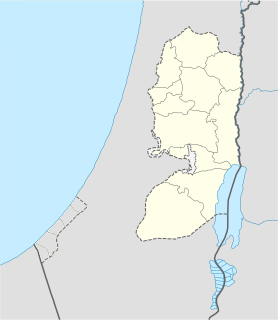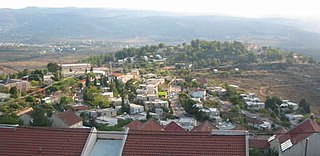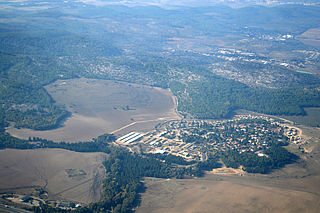
Moreh is the name of a location or a person mentioned several times in the Hebrew Bible.
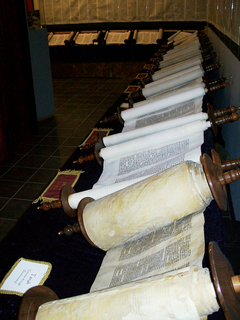
The Hebrew Bible, which is also called the Tanakh or sometimes the Mikra, is the canonical collection of Hebrew scriptures. These texts are almost exclusively in Biblical Hebrew, except for some Biblical Aramaic passages in the books of Daniel and Ezra. The Hebrew Bible is also the textual source for the Christian Old Testament. The form of this text that is authoritative for Rabbinic Judaism is known as the Masoretic Text (MT) and it consists of 24 books, while the translations divide essentially the same material into 39 books for the Protestant Bible.
Contents
Giv'at ha-More (Hebrew: גבעת המורה; English also as Giv'at ha-Moreh, Givat HaMoreh etc.; in the Septuagint the hill's Hebrew name was transliterated into 3rd Century BCE Greek as Γαβααθ Αμωρα, "Gabaath Amora") or Jebel Dahi in Arabic, is a mountain range in northern Israel, located on the northeast side of the Jezreel Valley. The highest peak reaches an altitude of 515 metres, while the bottom of the Jezreel Valley is situated at an altitude of 50–100 metres. North of it are the plains of the Lower Galilee, out of which about 8 kilometers away appears the more isolated Mount Tabor. In easterly direction Giv'at ha-More connects to the Issachar Plateau. To the southeast Giv'at ha-More descends into the Harod Valley, where the Harod spring flows eastwards into the Jordan Valley.

The Septuagint is the earliest extant Koine Greek translation of the Hebrew scriptures. It is estimated that the first five books of the Hebrew Bible, known as the Torah or Pentateuch, were translated in the mid-3rd century BCE and the remaining texts were translated in the 2nd century BCE. The Septuagint was the Koine Greek translation of the Hebrew Old Testament and was in wide use by the time of Jesus and Paul of Tarsus because most Jews could no longer read Hebrew. For this reason it is quoted more often than the Hebrew Old Testament in the New Testament, particularly in the Pauline epistles, by the Apostolic Fathers, and later by the Greek Church Fathers.

Greek is an independent branch of the Indo-European family of languages, native to Greece, Cyprus and other parts of the Eastern Mediterranean and the Black Sea. It has the longest documented history of any living Indo-European language, spanning more than 3000 years of written records. Its writing system has been the Greek alphabet for the major part of its history; other systems, such as Linear B and the Cypriot syllabary, were used previously. The alphabet arose from the Phoenician script and was in turn the basis of the Latin, Cyrillic, Armenian, Coptic, Gothic, and many other writing systems.

Israel, also known as the State of Israel, is a country in Western Asia, located on the southeastern shore of the Mediterranean Sea and the northern shore of the Red Sea. It has land borders with Lebanon to the north, Syria to the northeast, Jordan on the east, the Palestinian territories of the West Bank and Gaza Strip to the east and west, respectively, and Egypt to the southwest. The country contains geographically diverse features within its relatively small area. Israel's economic and technological center is Tel Aviv, while its seat of government and proclaimed capital is Jerusalem, although the state's sovereignty over Jerusalem has only partial recognition.
Arabs call this mountain Jebel Dahi after the Muslim shrine of Nabi Dahi (lit. Prophet Dahi) situated at its top, and holding the tomb of the 7th-century saint Nabi Dihyah Wahi al-Kalbi. [1]
In the 20th century, in the valley below the mountain, the city of Afula was developed as the main Jewish center of the region. Afula gradually expanded from the plains to the slopes of Giv'at ha-More. [1] During the War of Independence in 1948, the area was completely dominated by Israeli forces, but local Arab population was not displaced. On the slopes of the mountain there are several Arab villages, especially ad-Dahi and Nein.
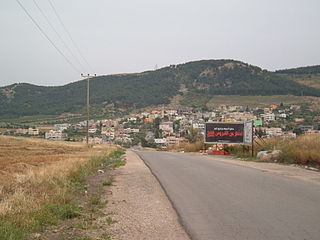
Nein — also Nain or Naim in English — is an Arab village in northern Israel. Located in the Lower Galilee, 14 kilometers (8.7 mi) south of Nazareth, Nein covers a land area of approximately 1,000 dunums and falls under the jurisdiction of Bustan al-Marj Regional Council, whose headquarters it hosts. Its total land area consisted of 3,737 dunums prior to 1962. According to the Israeli Central Bureau of Statistics, in 2018 it had a population of 1,845.
On the central part of Giv'at ha-More there is a nature reserve, partly wooded thanks to the activities of the Jewish National Fund. The Nazareth Iris blooms here in spring. [1]
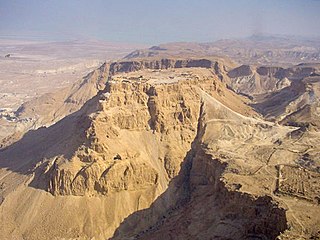
National parks of Israel are declared historic sites or nature reserves, which are mostly operated and maintained by the National Nature and Parks Authority. As of 2015, Israel maintains more than 400 nature reserves that protect 2,500 species of indigenous wild plants, 32 species of fish, 530 species of birds and 100 species of mammals.

Jewish National Fund was founded in 1901 to buy and develop land in Ottoman Palestine for Jewish settlement. The JNF is a non-profit organization. By 2007, it owned 13% of the total land in Israel. Since its inception, the JNF says it has planted over 240 million trees in Israel. It has also built 180 dams and reservoirs, developed 250,000 acres (1,000 km2) of land and established more than 1,000 parks.

Iris bismarckiana is a species in the genus Iris, it is also in the subgenus of Iris and in the Oncocyclus section. It is a rhizomatous perennial, from the mountainsides of Israel, Lebanon, Jordan and Syria. It has stoloniferous, spreading rhizomes, long, sword shaped, bright green leaves, long slender stem and 1 flower in Spring. The large flower is pale yellow, creamy-white, or white background. Which is covered with reddish-brown, maroon brown, purple-brown, purple, blue-purple, or blue veins, markings or spots. It has a dark signal patch and dark purple to black beard. It is rarely cultivated as an ornamental plant in temperate regions, as it needs very dry conditions during the summer.
